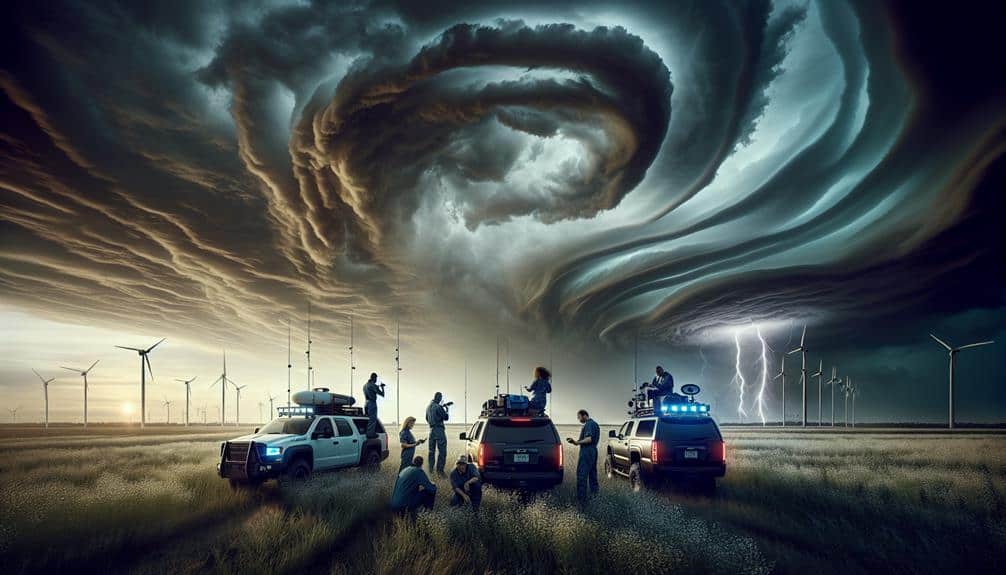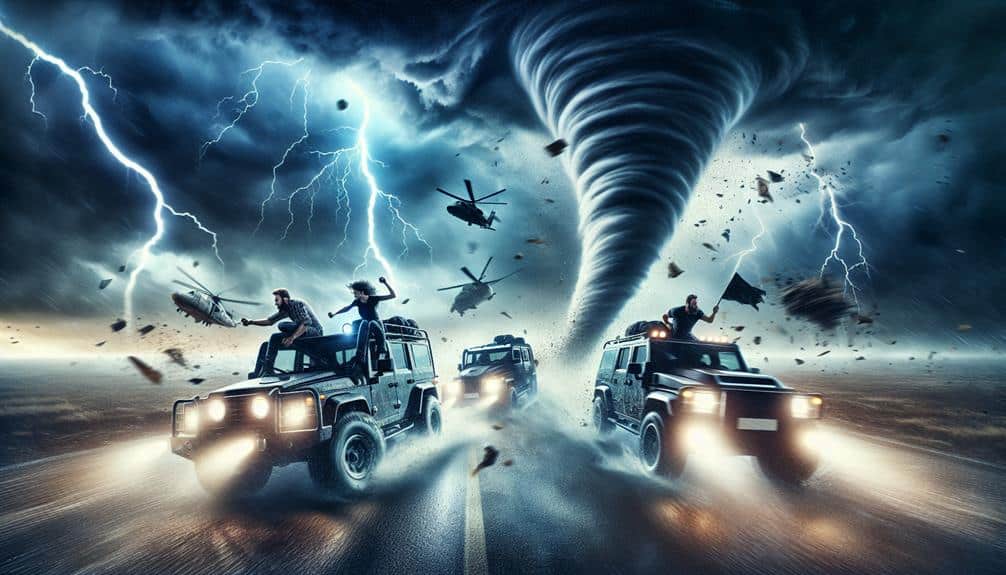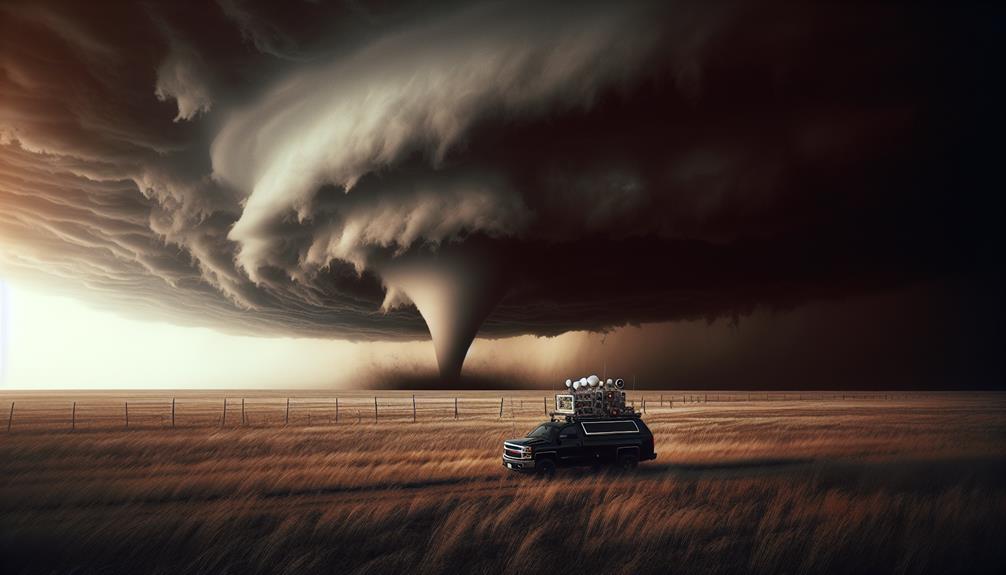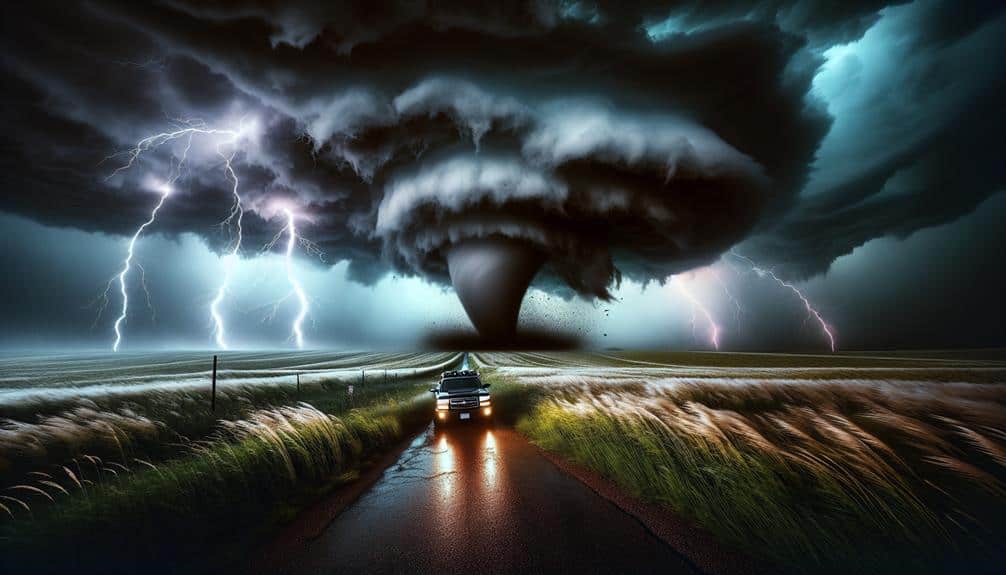We explore the exciting world of storm chasing hobbyists, merging scientific inquiry with high-stakes adventure. This pursuit, rooted in the 1950s by figures like David Hoadley, employs advanced tools like anemometers and weather radios to study severe weather. Iconic locations like Tornado Alley and Lake Maracaibo offer prime conditions for witnessing phenomena such as tornadoes and lightning storms. Essential gear and careful risk assessment guarantee safety. Enthusiasts gather at conventions and online forums to share data and strategies. By understanding the science and community dynamics, we'll uncover the delicate balance between excitement and rigorous safety protocols.
Key Points
- Storm chasing began in the 1950s with meteorologists seeking to understand severe weather.
- Essential gear includes weather radios, dash cameras, anemometers, and first aid kits.
- Tornado Alley and Lake Maracaibo are popular storm chasing locations.
- Safety tips include staying informed, risk assessment, using protective gear, and having emergency plans.
History of Storm Chasing
Storm chasing began in the 1950s as meteorologists and researchers sought to understand severe weather phenomena by directly observing and documenting storms in the field. Early pioneers like David Hoadley and Neil Ward laid the groundwork for systematic storm observations, venturing into dangerous weather with rudimentary equipment. They used basic meteorological tools such as anemometers and barometers, relying heavily on visual cues and rudimentary radar systems to track storm developments.
As time progressed, modern technology revolutionized our approach to storm chasing. The advent of Doppler radar in the 1980s allowed for more precise tracking of storm rotations and wind velocities. Mobile weather stations and laptops equipped with real-time data feeds became indispensable.
High-resolution satellite imagery and GPS technology further enhanced our ability to predict and follow storm paths with unprecedented accuracy.
Today, we leverage this advanced technology to not only chase storms but also to gather invaluable data that contributes to meteorological research and public safety. The blend of early pioneering spirit and cutting-edge technology continues to drive our passion for storm chasing, offering us a unique sense of freedom and adventure as we explore the dynamic forces of nature.
Essential Gear for Chasers
To effectively and safely pursue severe weather, we rely on a well-equipped arsenal of specialized gear designed to withstand extreme conditions and capture crucial data. Our gear selection is essential; it guarantees that we can document storms accurately and protect ourselves in the process.
Here's what we consider necessary:
- Weather Radios: These provide real-time updates on weather conditions, ensuring we stay informed about any changes in storm patterns or potential hazards.
- Dash Cameras: High-resolution cameras mounted on our vehicles capture visual data, which is invaluable for post-chase analysis and sharing our findings with the scientific community.
- Anemometers: These handheld devices measure wind speed and direction, giving us vital information about storm intensity and movement.
Maintaining our equipment is just as important as selecting it. Regular equipment maintenance ensures reliability in the field; for instance, calibrating anemometers and checking battery levels on weather radios can prevent unexpected failures.
Popular Storm Chasing Locations
Identifying prime storm chasing locations involves analyzing meteorological data to pinpoint regions with a high frequency of severe weather events. Our primary focus often lands on Tornado Alley, USA, renowned for its prolific tornado activity. This region, spanning parts of Texas, Oklahoma, Kansas, and Nebraska, offers the ideal conditions for supercell thunderstorms. Meteorological data reveals that the convergence of warm, moist air from the Gulf of Mexico and cold, dry air from the Rockies creates an excellent environment for tornado formation. With an average of over 1,200 tornadoes annually in the US, Tornado Alley is a haven for storm chasers seeking the thrill of these powerful phenomena.
Another hotspot for storm chasing is Lake Maracaibo in Venezuela, also known as the Lightning Capital. Here, the unique topography and meteorological conditions lead to the Catatumbo lightning phenomenon, characterized by intense lightning storms that occur up to 260 nights a year. Data indicates that this area experiences over 1.2 million lightning strikes annually. The reliable frequency and intensity of these storms make it an irresistible destination for those of us captivated by the raw power of nature's electrical displays.
In these regions, the allure of extreme weather draws us in, offering both excitement and scientific discovery.
Safety Tips for Hobbyists
While the thrill of chasing tornadoes in Tornado Alley or witnessing the Catatumbo lightning in Venezuela is undeniable, guaranteeing our safety during these adventures requires strict adherence to well-established guidelines. Effective storm chasing involves emergency plans, thorough preparation, and rigorous risk assessment. Without these, we expose ourselves to avoidable hazards.
First and foremost, we must create and rehearse our emergency plans. This includes identifying evacuation routes and having a reliable communication strategy. Preparation is paramount; our vehicles should be stocked with essential supplies like first aid kits, water, and non-perishable food.
Here are some essential safety tips to remember:
- Stay Informed: Utilize real-time meteorological data and updates from trusted sources. Understanding storm trajectories can prevent us from being caught off guard.
- Risk Assessment: Regularly evaluate the risks associated with the storm's intensity and our proximity. Adjust our position accordingly to maintain a safe distance.
- Precautions: Equip ourselves with protective gear such as helmets and sturdy footwear. This minimizes injuries from debris or sudden environmental changes.
Community and Events

Storm chasing communities foster collaboration through organized events, where enthusiasts share data, techniques, and experiences to enhance their collective knowledge and safety. Our annual conventions serve as a pivotal platform for networking opportunities, allowing us to connect with both seasoned chasers and newcomers. At these conventions, we attend workshops on advanced meteorological models, radar interpretation, and storm structure analysis. This exchange of knowledge guarantees that we remain at the cutting edge of storm chasing science.
In addition to these large-scale events, we also engage in smaller group excursions. These trips are meticulously planned, often using data from online forums where members discuss weather patterns, storm tracks, and potential chase targets. By pooling our resources and expertise, we maximize our chances of successfully intercepting severe weather events while minimizing risks.
Online forums play an essential role in our community, offering a space for continuous learning and real-time updates. These digital platforms facilitate instant communication, allowing us to share live data, photographs, and videos of storm developments.
This collective intelligence, harnessed through both in-person and online interactions, empowers us to chase more effectively and safely, all while fostering a sense of camaraderie and shared adventure.
Frequently Asked Questions
How Do Storm Chasers Predict Where a Storm Will Develop?
Did you know that 85% of tornadoes occur in the U.S.? We analyze weather patterns using advanced technology to predict storms, aiming for chance encounters that give us an adrenaline rush while ensuring scientific accuracy and safety.
What Motivates People to Become Storm Chasers?
We're motivated by a psychological fascination with extreme weather, the adrenaline rush from close encounters, and a passion for weather science. Thrill-seeking drives us to chase storms, combining our curiosity with data-driven research for freedom and adventure.
Are There Any Age Restrictions for Storm Chasing?
Yes, there are age restrictions for storm chasing. Safety precautions necessitate that minors obtain parental consent. Data indicates experienced adults manage risks better, ensuring a safer and more informative experience for all participants.
How Do Storm Chasers Document Their Experiences?
We document our storm chasing experiences using advanced photography techniques and high-resolution storm chasing videos. We share real-time updates on social media and leverage weather apps for accurate data. This guarantees our audience experiences the thrill freely.
Can Storm Chasing Be a Full-Time Career?
Sailing the stormy seas of career prospects, we find storm chasing can indeed be a full-time career. However, it often lacks financial stability, relying heavily on data collection, media sales, and occasional scientific grants to sustain us.


